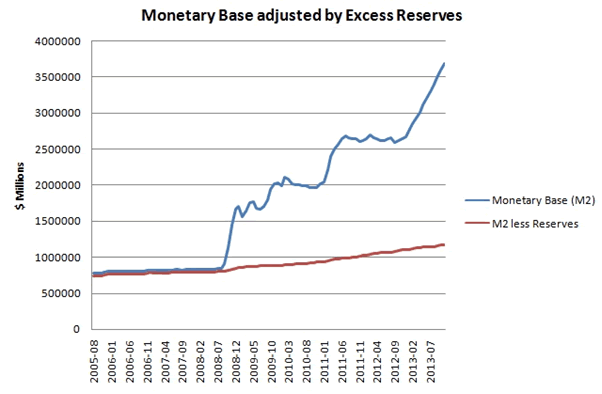Behind the Fed’s Magical Curtain: The US Monetary Base and the Impact of Excess Reserves
Interest-Rates / US Federal Reserve Bank Jan 02, 2014 - 03:30 PM GMTBy: Submissions
 Kim Collard writes: The Federal Reserves actions since the Global Financial Crisis have been watched and analysed more than at any other time in history. This makes pretty good sense, as its actions have obviously had a profound impact on these markets.
Kim Collard writes: The Federal Reserves actions since the Global Financial Crisis have been watched and analysed more than at any other time in history. This makes pretty good sense, as its actions have obviously had a profound impact on these markets.
However, I believe all the many and varied analyses of these actions have fallen into a carefully laid perception trap.
The Fed is the inheritor of 100 years of Central Bank experience, starting with the extraordinary JP Morgan himself. Such experience has learnt, often very painfully, a number of important lessons.
One such lesson is that if you increase the money supply you boost economic activity in the short to medium term. However, if you boost money supply for too long, you debase the currency which leads to inflation and ultimately to Zimbabwe or the Weimar Republic.
So in a Great Financial crisis you would really like to increase the Money Supply for the boost in activity but you don’t want these terrible consequences.
On the other side of the same (Hegelian) coin; if you do not increase the Money Supply in a Great Financial Crisis to offset the massive destruction of financial assets that’s just occurred; then you get deflation and a huge Depression. So what to do?
These lessons have been seared into the souls of generations Central Bank Presidents, so what did they do?
The answer it seems to me is the do both simultaneously, while at the same time doing neither. The Alice (in Wonderland) solution if you will.
See the graph of Federal Reserve statistical data below.

Data from: Aggregate Reserves of Depository Institutions and the Monetary Base - H.3
The Federal Reserve announced a series of what became known as Quantative Easings which increased the Money Supply and so was seen as inflationary and leading to the Zimbabwean road. Gold jumped, the stock market jumped and the economy stopped its precipitous decline.
As each new Quantitative Easing was announced it had a similar but apparently reduced affect.
So if you look at the M2 line on the graph, the Quantitative easing and so increase in Money Supply has been turbo charged at various points along the way, to keep up its ‘good’ effect.
However, at the same time the Federal Reserve has been paying interest on Excess Reserves and so the participating banks have been leaving vast reserves on deposit with the Fed.
Now, it is worth noting that the Federal Reserve is actually an industry self-governing body. So behind the curtain they agree with themselves to keep these funds on deposit and so not release them into the economy. The equivalent of printing money, but then burying it in your backyard.
It makes you feel good, but changes nothing else. And that’s actually the point.
So by increasing M2 but burying the increased money supply in the back yard (holding it as Excess Reserves) you get the full confidence effect without the bad aftertaste.
The actual increase in effective M2 is the bottom line shown on the graph. Now that increase since the onset of the crisis is some 42%, so quite useful in itself. However it is nothing like the 242% shown in the top line, which has been driving the full Alice effect.
However eventually people do start to notice there is no inflation (and even some creeping deflation), the economy improves but doesn’t boom like the expected crackup following an increase like that shown in the top line of the graph. Gold suddenly crashes like a canary, leaving the question what now and what next and thenwhat other rabbits can be conjured from behind the curtain?
So should I summarise with, you can fool all of the people for some of the time, (but as I just figured this out) it must mean you can’t fool all of the people, all of the time.
But, why do I suddenly wish I had just kept this all to myself?
By Kim Collard
© 2013 Copyright Kim Collard - All Rights Reserved
Disclaimer: The above is a matter of opinion provided for general information purposes only and is not intended as investment advice. Information and analysis above are derived from sources and utilising methods believed to be reliable, but we cannot accept responsibility for any losses you may incur as a result of this analysis. Individuals should consult with their personal financial advisors.
© 2005-2022 http://www.MarketOracle.co.uk - The Market Oracle is a FREE Daily Financial Markets Analysis & Forecasting online publication.



